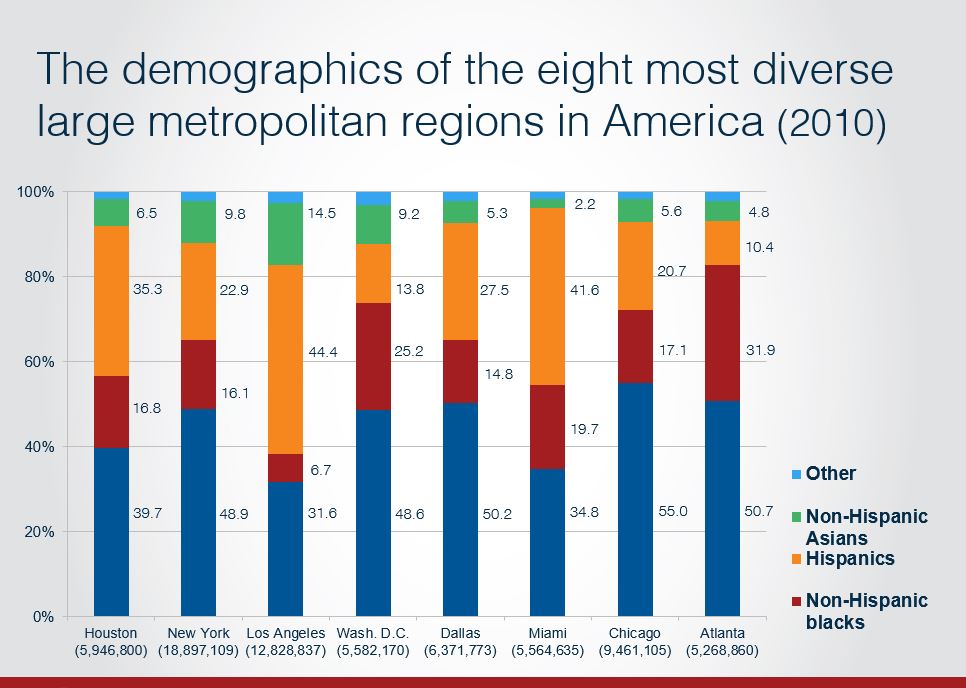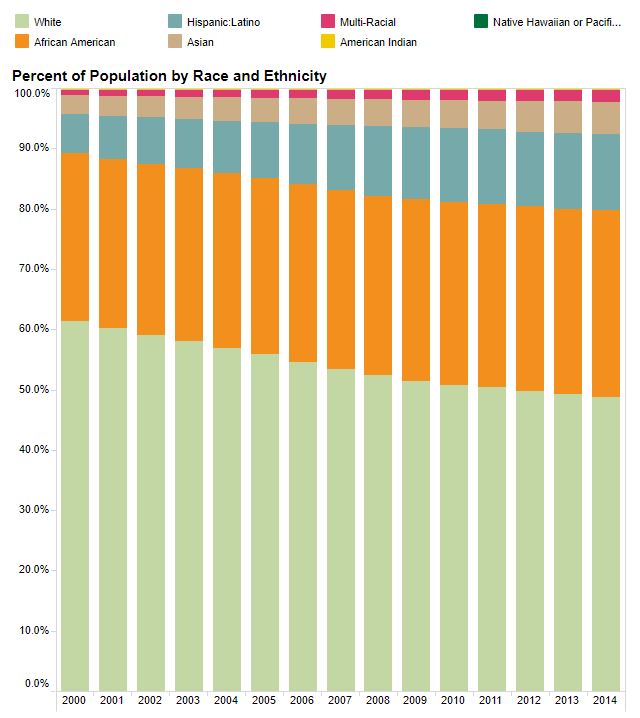Can Sun Belt sibling cities learn from each other?

HOUSTON — One city was built on oil and shipping in a hot, humid swampy spot laced with small waterways. Its former biracial dynamics have changed, as immigration boosted Latino and Asian populations. It’s growing rapidly – and that includes rapid growth in income inequality.
Another city was built on textiles and banking in a hot, humid but rolling spot laced with small waterways. Its former biracial dynamics have changed, as immigration boosted Latino and Asian populations. It’s growing rapidly – and that includes rapid growth in income inequality.
I spent a few days recently in the first city, Houston, and I live in the other, Charlotte. Though residents might not see the resemblances, the more I heard and saw the more I was struck by similarities. And for Charlotteans, Houston may well provide a glimpse of our future.
| How Houston thinks big in funding its greenway plan |
Consider these additional similarities between the two Sun Belt siblings. Both cities:
- Benefited from liberal annexation laws that let them grow by absorbing sprawling suburban neighborhoods – although the state in recent years has clipped that easy annexation.
- Have small light rail systems, with some recent expansions.
- Are trying to build greenways along their networks of small waterways.
- Have become reliably Democratic islands in states with Republican-dominated state governments.
- Pride themselves on a business-friendly culture and on looking forward, not clinging to the past.
Of course there are differences, too:
- While Charlotte’s early Scots-Irish settlers were fighting General Cornwallis’ Brits for independence in 1780, Houston was just a swampy place in the Spanish Empire.
- And independence, in Texas, was for real: the Republic of Texas lasted from 1836 to 1846.
- Unlike Charlotte, Houston has no zoning ordinance. However, the city looks remarkably like all those other U.S. cities that do have zoning.
- And yes, size matters. Houston is the fourth largest U.S. city. Its population was already almost 600,000 by 1950 (Charlotte was 134,000) and zoomed to 1.2 million by 1970 – boosted by the spread of air conditioning through the South. Today it has 2.3 million people, compared to Charlotte’s 842,000. Houston’s metro area population is 6.8 million compared with the Charlotte-Concord-Gastonia metro area’s 2.5 million.
Among many other differences, a particularly notable one is Houston’s cultural landscape. Its civic and cultural institutions have benefited from major philanthropic gifts from family fortunes, many built on oil money. The Houston Symphony’s endowment totaled $82 million in 2014. Compare that to the Charlotte Symphony’s endowment of $5 million as of 2015. The Museum of Fine Arts, Houston, lists an endowment worth $1.14 billion, with patrons including the one-time chief operating officer of the ill-fated Enron, Richard Kinder, who left Enron some years before its collapse and founded what’s now one of the nation’s largest oil and gas pipeline companies. Charlotte’s Mint Museum of Art had an endowment worth $40 million in 2011.
 Houston’s light rail system opened in 2004 after years of struggles to find funding. It was originally built with no federal funding due to opposition from former U.S. Rep. Tom DeLay. A Red Line expansion opened in 2013, and two other lines, the Purple and Green, opened in 2015. This Red Line stop is in the huge Texas Medical Center area south of downtown, near Rice University. Photo: Mary Newsom
Houston’s light rail system opened in 2004 after years of struggles to find funding. It was originally built with no federal funding due to opposition from former U.S. Rep. Tom DeLay. A Red Line expansion opened in 2013, and two other lines, the Purple and Green, opened in 2015. This Red Line stop is in the huge Texas Medical Center area south of downtown, near Rice University. Photo: Mary Newsom
I pondered all this during a confab in Houston of academics and others from cities in the Sun Belt, discussing whether we might form a more formal partnership to research the issues our cities have in common. Among the cities represented at the session – sponsored by Rice University’s Kinder Institute for Urban Research (yes, that Kinder) – were San Diego, Las Vegas, Phoenix, Nashville and Chapel Hill, as well as Charlotte.
Why pay attention to Sun Belt cities as a separate genre? After all, they’re not the only ones facing the problems of housing affordability (or lack of), or the growth of a two-tiered service economy, or rising income inequality and lack of economic mobility. But many of the Sun Belt cities share some attributes that mean any solutions to the aforementioned problems will likely differ from solutions in places like Cleveland or Boston or Chicago. Problems Sun Belt cities share – in addition to rising heat (See, “As Climate Changes, Southern States Will Suffer More Than Others”):
- Fast growth. As Kinder Institute Director Bill Fulton pointed out, 21 large Sun Belt metros accounted for 44 percent of all the nation’s population growth 2010-2016.
- The largest are confronting the limits of an auto-oriented urban form, as traffic congestion grows ever worse.
- They tend to be newer to big-city status, and so have weaker philanthropic and nonprofit infrastructure.
- With the national trend toward suburbanization of poverty, their issues of sprawl, distance and lack of transit can exacerbate the problems low-income families face.
- Many Sun Belt cities are in states with a low-tax, low-regulation environment, so government and policy tools available in other regions may not be available to Sun Belt cities.
Despite their Sun Belt kinship, though, in Charlotte we can easily look at a city like Houston and pick out reasons it’s different. But Stephen L. Klineberg, who for 36 years has conducted an intensive survey, the Kinder Houston Area Survey, believes Houston illustrates trends that will be seen in other U.S. cities in coming years. He calls Houston “the prophetic city.”
Key to his analysis is the rapid change in the city’s ethnic diversity. “No city has been transformed as fully, completely and suddenly as Houston,” he says. Of the nation’s eight most diverse large metro areas, Houston is the most balanced among Anglos, blacks, Latinos and Asians.
 Chart courtesy Houston Area Survey, Kinder Institute for Urban Research
Chart courtesy Houston Area Survey, Kinder Institute for Urban Research
Until the early 1980s it was what he called a bi-racial Southern city. But after the 1982 oil bust, he says, the Anglo population stopped growing. And “63-year-old Anglos are not going to be making a whole lot more babies,” he says. In terms of Houston’s ethnic diversity, he says, “This is a done deal.”
Charlotte has seen similar changes, although not as drastic as Houston. For instance, while the Mecklenburg County ethnic breakdown more closely resembles Houston’s, Charlotte’s 10-county metro area is less balanced among different ethnic groups.
ETHNIC MAKEUP OF MECKLENBURG COUNTY 2000-2014
 Source: UNC Charlotte Urban Institute
Source: UNC Charlotte Urban Institute
As Houston goes, so goes Charlotte? It’s a prediction. But will Klineberg’s vision of Houston as a city prophesying the future for other U.S. cities come true? The next 20 years may well hold the answer. In the meantime, keep your eye on the other hot cities of the Sun Belt. How they handle their growth could hold important lessons for Charlotte and all its Sun Belt siblings.